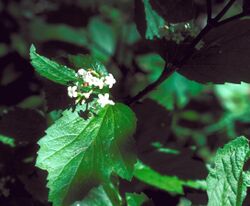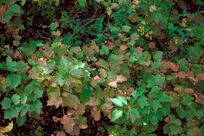Biology:Viburnum edule
| Squashberry | |
|---|---|

| |
| Scientific classification | |
| Kingdom: | Plantae |
| Clade: | Tracheophytes |
| Clade: | Angiosperms |
| Clade: | Eudicots |
| Clade: | Asterids |
| Order: | Dipsacales |
| Family: | Adoxaceae |
| Genus: | Viburnum |
| Species: | V. edule
|
| Binomial name | |
| Viburnum edule (Michx.) Raf.
| |
Viburnum edule, the squashberry,[1] mooseberry,[1] moosomin,[2][3] moosewood viburnum,[4] pembina,[5][6] pimina,[7] highbush cranberry,[8] or lowbush cranberry[8] is a species of shrub native to Canada and the northern parts of the US. It stands roughly 2 m (6.5 ft) tall with many stems and smooth branches.[9]
The tart berries ripen early in spring[10] and are eaten by various birds and mammals.[4] With the seeds removed, they are edible to humans as well,[11] and can be made into jam.[10]
Description
It is a deciduous, dicot shrub growing 0.5–3.5 m (1.5–11.5 ft) tall. The leaves are opposite, elliptic in shape, 6–10 cm (2.4–3.9 in) long, unlobed or shallowly 3-lobed, jaggedly serrated, and turning red in autumn; their underside glabrous, especially along the veins.[12][13] The bark is smooth and reddish grey in colour, the twigs glabrous. The flowers are arranged in a small, compact, and flat or rounded inflorescence 1–3 cm (0.4–1.2 in) across consisting of several flowers.[12] The flowers are synoecious and fertile, the petals white and fused at the base forming a tube that flares into 5 lobes at the top; the stamens short (≤ 1mm)[12][13] and hidden within the corolla.[7] The fruit is an edible red or orange berry-like drupe, 0.8–1.5 cm (0.3–0.6 in) long, arranged in clusters, each fruit containing a single, flattened stone.[12][13]
Taxonomy and etymology
French botanist André Michaux is the first recorded authority to provide a scientific name for the plant, calling it Viburnum opulus var. Pimina or Viburnum trilobum var. edule in 1803.[7] The name edule is derived from the latin word ĕdūlis, meaning edible.[14] The name Pimina refers to the common name for the plant used in Canada at the time.[7] French naturalist Constantine Samuel Rafinesque observed the plant later in 1808, calling it Viburnum edule, V. opulus var. of Michaux. Lacking communication and consensus between naming authorities resulted in further names being provided for the same plant, the most popular being Viburnum pauciflorum. The discrepancy was eventually resolved, and the name Viburnum edule became the commonly accepted scientific name that is still in use today.[7]
Viburnum edule was originally categorized as a member of the Caprifoliaceae (honeysuckle) family, however phylogenetic analysis has caused the plant to be re-classified as a member of the Adoxaceae (moschatel) family.[15][16]
Distribution and habitat
Squashberry can be found growing in moist soils of various forested regions.[17] It is also found growing in dense areas of trees and shrubs, alongside wetlands and bodies of water, and at higher elevations on gravel banks.[6] The ideal type of soil for Viburnum edule is moist alluvial soil that has good drainage.[6] This plant is dispersed through animals, such as birds and mammals, that carry, eat, digest, and excrete the seeds in different areas.[6] Squashberry is distributed across Canada, all throughout Alaska, and in northern states of the USA.[6][18] Specifically, it can abundantly be found in the following regions: the Yukon, northern Quebec, western District of Mackenzie to James Bay, south Newfoundland to Oregon, Idaho, Colorado, Minnesota and Pennsylvania.[19] It will be found either as a dominant or codominant understory plant of coniferous forests.[20] Oftentimes, squashberry grows abundantly in Picea glauca (white spruce) forests.[20] Squashberry is also known to be an important pioneer species that grows early after forest fires.[21]
Cultivation and uses
The tart fruit is commonly consumed fresh, however it can also be used to prepare foods such as jams and jellies.[6][22] Many animals consume the wild berries as a part of their diet, while smaller animals can use the plant as shelter.[6][23]
Multiple parts of the Viburnum edule plant have been used in herbal medicine. The berries can be used to prepare herbal cough medicines, while the roots have been used to make tea for relief of tooth pain or a sore throat.[6] The twigs of the plant can be chewed or gargled as a tea to also treat sore throat.[6] Lip sores have been treated by massaging the closed flower buds of V. edule on the lips.[6] Modern research efforts have found that the fruit contains high levels of antioxidants.[24][25]
Numerous Indigenous peoples have traditionally used the plant. The Nuxalk people from the Bella Coola region of British Columbia utilize the berries for food due to the plant's rapid growth rate and high berry production.[26] Notably, a single Viburnum edule shrub can produce a yield of up to 100 berries.[27] Multiple First Nations groups on the northwestern coast of North America have cultivated Viburnum edule plants, planting them in wild forest gardens.[28][29] Consumption of the berries was mentioned in multiple origin myths of the Haida people,[30] often depicted as the food eaten at feasts or consumed by supernatural beings.[22] Inuit peoples near the Nain settlement in Newfoundland and Labrador are also known to traditionally collect the wild fruits.[31]
References
- ↑ 1.0 1.1 USDA GRIN Taxonomy, https://npgsweb.ars-grin.gov/gringlobal/taxonomydetail.aspx?id=41348, retrieved 9 April 2016
- ↑ "Biography – MŌSŌMIN – Volume XIII (1901-1910) – Dictionary of Canadian Biography". http://www.biographi.ca/en/bio/mosomin_13E.html.
- ↑ "About Moosimin First Nation". 2020. https://www.saskatoon.ca/sites/default/files/documents/community-services/planning-development/future-growth/urban-reserves-treaty-land-entitlement/fnp_moosomin.pdf.
- ↑ 4.0 4.1 Whitney, Stephen (1985). Western Forests (The Audubon Society Nature Guides). New York: Knopf. p. 436. ISBN 0-394-73127-1. https://archive.org/details/westernforests00whit/page/436.
- ↑ The WPA Guide To 1930s North Dakota (2nd ed.). State Historical Society of North Dakota. 1977. p. 223. ISBN 1891419145. OCLC 317825870.
- ↑ 6.0 6.1 6.2 6.3 6.4 6.5 6.6 6.7 6.8 6.9 Gould, K.; Wood, S.; Smreciu, A. (2013-10-18) (in en). Viburnum edule: lowbush cranberry, mooseberry, squashberry, squawberry, crampbark, pembina. doi:10.7939/r34m91c8x. https://era.library.ualberta.ca/items/2537ecb8-522b-44fc-9b91-878f19a33910. Retrieved 2021-12-04.
- ↑ 7.0 7.1 7.2 7.3 7.4 Fernald, M. L. (1941). "Viburnum Edule and ITS Nomenclature". Rhodora 43 (513): 481–483. https://www.jstor.org/stable/23301874.
- ↑ 8.0 8.1 Matthews, Robin F.. "Viburnum edule". U.S. Department of Agriculture, Forest Service, Rocky Mountain Research Station, Fire Sciences Laboratory. https://www.fs.fed.us/database/feis/plants/shrub/vibedu/all.html.
- ↑ USDA PLANTS database, http://plants.usda.gov/core/profile?symbol=VIED, retrieved 15 August 2015
- ↑ 10.0 10.1 Benoliel, Doug (2011). Northwest Foraging: The Classic Guide to Edible Plants of the Pacific Northwest (Rev. and updated ed.). Seattle, WA: Skipstone. pp. 101. ISBN 978-1-59485-366-1. OCLC 668195076.
- ↑ Elias, Thomas S.; Dykeman, Peter A. (2009). Edible Wild Plants: A North American Field Guide to Over 200 Natural Foods. New York: Sterling. pp. 227. ISBN 978-1-4027-6715-9. OCLC 244766414.
- ↑ 12.0 12.1 12.2 12.3 Douglas, George W, ed (1998) (in English). Illustrated Flora of British Columbia. Volume 2: Dicotyledons (Balsaminaceae Through Cucurbitaceae). Victoria, B.C.: B.C. Ministry of Environment. pp. 228–229. ISBN 0772636850.
- ↑ 13.0 13.1 13.2 Moss, E. H. (1983). Flora of Alberta: a manual of flowering plants, conifers, ferns and fern allies found growing without cultivation in the province of Alberta, Canada (2nd ed.). University of Toronto Press. pp. 515. ISBN 978-1-4426-5737-3. OCLC 903968374.
- ↑ Lewis, Charlton T.; Short, Charles (1879). A Latin Dictionary. Oxford: Clarendon Press. http://www.perseus.tufts.edu/hopper/text?doc=Perseus:text:1999.04.0059:entry=edulis.
- ↑ "Dipsacales". http://www.mobot.org/MOBOT/research/APweb/orders/dipsacalesweb.htm#Viburnaceae.
- ↑ "Viburnaceae Raf. | Plants of the World Online | Kew Science" (in en). http://powo.science.kew.org/taxon/urn:lsid:ipni.org:names:77162522-1.
- ↑ Inkpen, Wayne; Van Eyk, Rob. Guide to the common native trees and shrubs of Alberta. Edmonton: Alberta Environmental Protection, Pesticide Management Branch. pp. 50.
- ↑ "Viburnum edule". https://www.fs.fed.us/database/feis/plants/shrub/vibedu/all.html#1.
- ↑ Moss, E. H.; John G. Packer (1983). Flora of Alberta: a manual of flowering plants, conifers, ferns, and fern allies found growing without cultivation in the Province of Alberta, Canada (2nd ed.). Toronto: University of Toronto Press. ISBN 0-8020-2508-0. OCLC 12217114.
- ↑ 20.0 20.1 Dyrness, C. T.; Cleve, K. Van; Levison, J. D. (1989-11-01). "The effect of wildfire on soil chemistry in four forest types in interior Alaska". Canadian Journal of Forest Research 19 (11): 1389–1396. doi:10.1139/x89-213. ISSN 0045-5067. https://cdnsciencepub.com/doi/pdf/10.1139/x89-213.
- ↑ Foote, M. Joan (1983). "Classification, description, and dynamics of plant communities after fire in the taiga of interior Alaska." (in en). Res. Pap. PNW-RP-307. Portland, OR: U.S. Department of Agriculture, Forest Service, Pacific Northwest Forest and Range Experiment Station. 116 P 307. doi:10.2737/PNW-RP-307. http://www.fs.usda.gov/treesearch/pubs/25349.
- ↑ 22.0 22.1 Turner, Nancy J. (2014). Ancient pathways, ancestral knowledge: ethnobotany and ecological wisdom of indigenous peoples of northwestern North America. 1. McGill-Queen's University Press. p. 69. ISBN 9780773543805. OCLC 1124369063.
- ↑ Tannas, Kathy (2001). Common plants of the western rangelands (2nd ed.). Edmonton: Alberta Agriculture, Food and Rural Development. ISBN 0-7732-6154-0. OCLC 48803622.
- ↑ Leiner, Roseann Hartke; Holloway, Patricia S.; Neal, David B. (2006). "Antioxidant Capacity and Quercetin Levels in Alaska Wild Berries". International Journal of Fruit Science 6 (1): 83–91. doi:10.1300/j492v06n01_06. ISSN 1553-8362.
- ↑ Rop, Otakar; Reznicek, Vojtech; Valsikova, Magdalena; Jurikova, Tunde; Mlcek, Jiri; Kramarova, Daniela (2010-06-23). "Antioxidant Properties of European Cranberrybush Fruit (Viburnum opulus var. edule)". Molecules 15 (6): 4467–4477. doi:10.3390/molecules15064467. ISSN 1420-3049. PMID 20657454.
- ↑ Lepofsky, Dana; Turner, Nancy J.; Kuhnlein, Harriet V. (1985). "Determining the availability of traditional wild plant foods: An example of Nuxalk foods, Bella Coola, British Columbia". Ecology of Food and Nutrition 16 (3): 223–241. doi:10.1080/03670244.1985.9990863. ISSN 0367-0244.
- ↑ Lepofsky, Dana; Turner, Nancy J.; Kuhnlein, Harriet V. (1985-05-01). "Determining the availability of traditional wild plant foods: An example of Nuxalk foods, Bella Coola, British Columbia". Ecology of Food and Nutrition 16 (3): 223–241. doi:10.1080/03670244.1985.9990863. ISSN 0367-0244.
- ↑ Turner, Nancy J. (2020). Plants, people, and places: the roles of ethnobotany and ethnoecology in Indigenous peoples' land rights in Canada and beyond. McGill-Queen's University Press. p. 126. ISBN 978-0-2280-0183-6. OCLC 1126217708.
- ↑ Deur, Douglas, ed (2006). Keeping It Living: Traditions of Plant Use and Cultivation on the Northwest Coast of North America. University of Washington Press. pp. 119. ISBN 978-0-295-98565-7.
- ↑ Swanton, John Reed (1905). Contributions to the ethnology of the Haida. Leiden E. J. Brill. pp. 25, 261.
- ↑ Boulanger-Lapointe, Noémie; Gérin-Lajoie, José; Siegwart Collier, Laura; Desrosiers, Sarah; Spiech, Carmen; Henry, Gregory H. R.; Hermanutz, Luise; Lévesque, Esther et al. (2019-01-11). "Berry Plants and Berry Picking in Inuit Nunangat: Traditions in a Changing Socio-Ecological Landscape". Human Ecology 47 (1): 81–93. doi:10.1007/s10745-018-0044-5. ISSN 0300-7839.
External links
Wikidata ☰ Q210366 entry
 |




